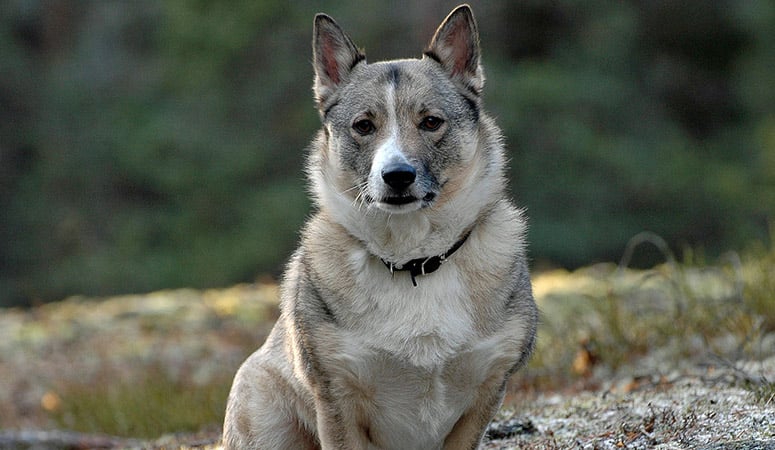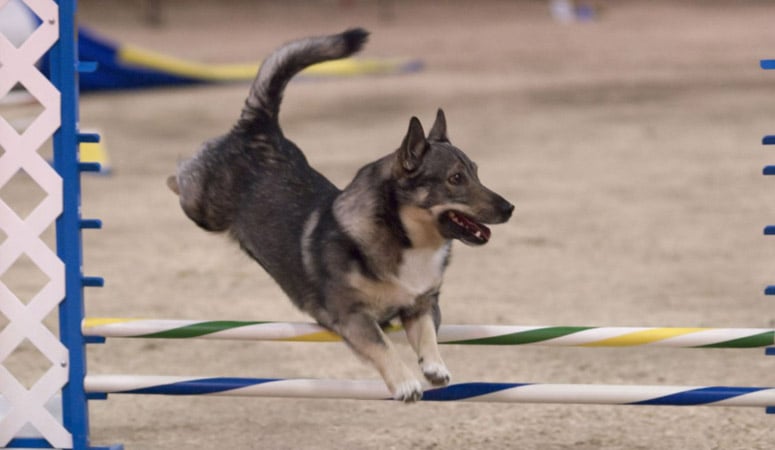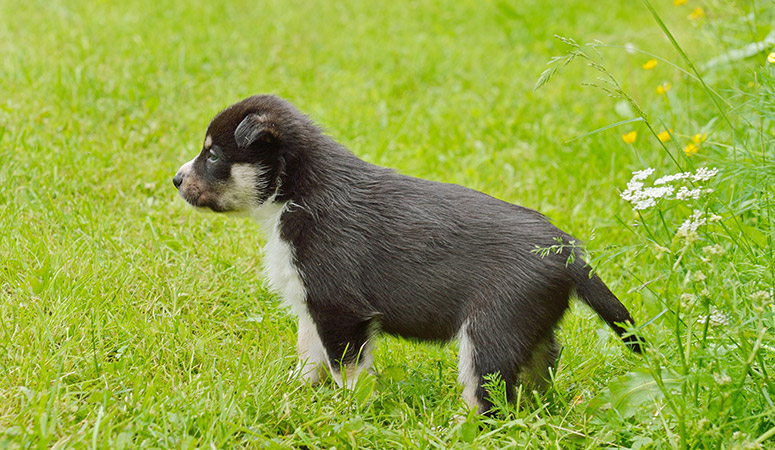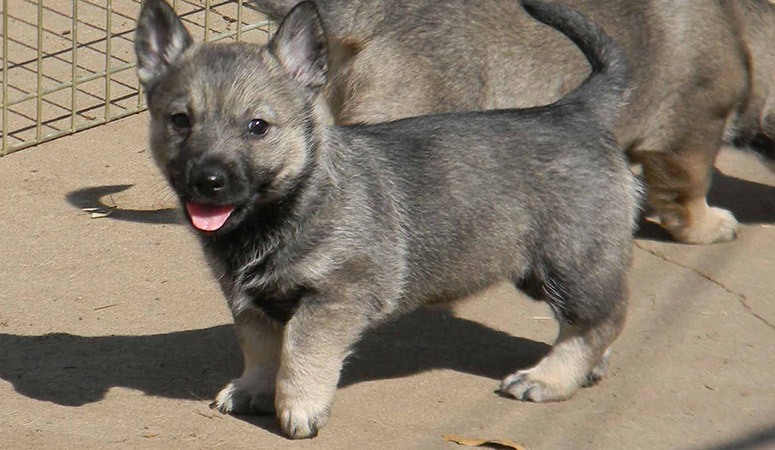Swedish Vallhund
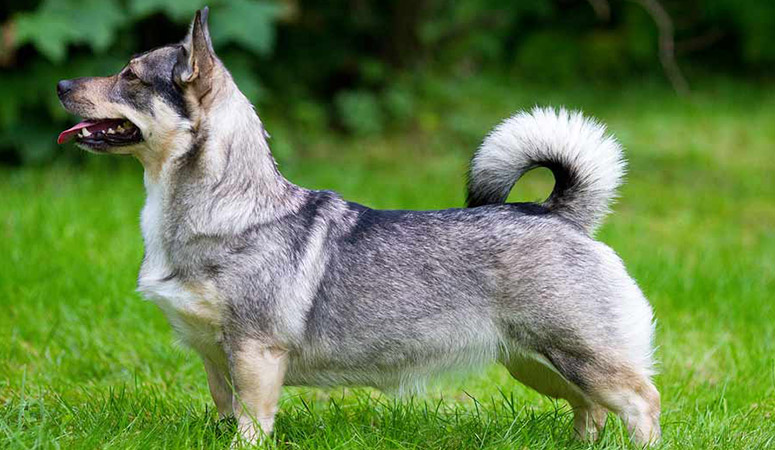
The Swedish Vallhund has longer legs and shorter body, which also giving them slightly more speed and agility. The breed hallmarks include balance, power, and smooth movement. As Viking Dog of ancient legend, they were bred to herd, but also served important roles as ratters and sentries, sounding an alarm at the first sign of danger.
| Other Names | Schwedischer Schaferspitz, Swedish Cattle Dog, Swedish Cattledog, Vastgotaspets, Viking Dog |
| Color | Gray, Red |
| Height | Males: 12-14 inches. Females: 11-13 inches. |
| Weight | Males: 20-35 pounds. Females: 20-35 pounds. |
| Life Span | 12-15 years |
| Personality | Friendly, Energetic, Watchful |
| Exercise | Needs Lots of Activity |
| Origin |
| Popularity | #159 |
| Groom Needs | Occasional Bath/Brush |
| Kids Friendly | Yes |
| Dog Friendly | Yes with supervision |
| Watch Dog | |
| Family Dog | |
| Litter Size | 6 to 8 puppies |
Swedish Vallhund Pictures
Swedish Vallhund Video
Introduction
The Swedish Vallhund is strong and powerful for its small size. It is compact and sturdily built for a hard day’s work. It has a wedge-shaped head and a long body. There’s glaring variation in the tail of one Swedish Vallhund and the other; while one may have a short tail, the other may have none at all. This is the reason for the wrong notion that their tails are often docked. Swedish Vallhunds are resilient, intelligent, and well-balanced on the ground they walk on. They come in a close-fitting, harsh and dense double coat. The topcoat is tightly fitted over the soft undercoat. Their coat varies widely in color from gray, grayish-yellow, grayish brown to reddish-brown.
A standard male stands at 12-14 inches from shoulder to paw and weighs around 20-35 pounds. The females run closely behind at 11-13 inches tall at the shoulder and weighing in the same range as the males. The AKC registered them as members of the Herding Group. Swedish Vallhunds have an average lifespan of 11-15 years.
Living with Swedish Vallhund
Swedish Vallhunds are very easy dogs to manage when it comes to grooming. Begin accustoming your Vallhund to being brushed and examined when he’s a puppy. Make grooming a positive experience filled with praise and rewards, and you’ll lay the groundwork for easy veterinary exams and other handling when he’s an adult.
They shed their undercoat twice a year, which will make you wonder just how many dogs you have, going by the snowdrifts of hair. When they are shedding, a warm bath and good massage when shampooing, followed by drying with a dryer and a thorough brushing, can get rid of the worst of it.
A Vallhund’s coat doesn’t need any special trimming. In fact, a Vallhund in the show ring is meant to appear in an untrimmed, natural state.
Swedish Vallhunds need a good, down-to-the-skin brushing occasionally. Get all the way down to the skin to remove dead hair and stimulate the sebaceous glands, which produce an oily substance that lubricates and protects hair and skin. Bathe when they get dirty.
Trim his nails once or twice a month if your dog doesn’t wear them down naturally. If you’re not experienced at trimming dog nails, ask a vet or groomer for pointers. Handle his paws frequently — dogs are touchy about their feet — and look inside his mouth.
Brush your Vallhund’s teeth at least two or three times a week to remove tartar buildup and the bacteria that lurk inside it. Daily brushing is even better if you want to prevent gum disease and bad breath.
Check ears weekly for redness or a bad odor, which can indicate an infection, and wipe them out with a cotton ball dampened with gentle, pH-balanced ear cleaner to help prevent infections. Don’t insert anything into the ear canal; just clean the outer ear.
Swedish Vallhunds need a medium to high level of activity. Some Swedish Vallhunds have more energy than others. Keep in mind that while this isn’t a breed intended to run all day, the Vallhund is a working farm dog and needs regular exercise.
One decent walk daily with some time playing fetch or performing a sport or other activity is likely adequate for most Vallhunds, but some need more. A long walk or short jog, along with a mentally challenging game, will usually satisfy their exercise needs. They also enjoy agility.
Mental exercise is necessary in addition to their physical exercise. Puzzle games, clicker training, and participating in a sport can all contribute to their mental and physical well-being.
With his short legs and long back, the Vallhund can be prone to back injuries if mishandled. Because their skeletal development is not yet complete, avoid letting puppies jump on and off furniture.
The Vallhund has a weather-resistant coat designed to withstand the harsh elements of Sweden, but that doesn’t mean he’s an outside dog. He is highly people-oriented and should never be shunted off to the backyard with little human interaction.
The Swedish Vallhund is a fairly small dog, so it is recommended that you feed it a dog food diet specially formulated for small-breed dogs, about 1 to 1.5 cups of high-quality dry food a day, divided into two meals.
It is also important to note that these little dogs are active, so an active-breed formula may also be a good option depending on your individual dog’s age, size, metabolism and activity level.
The quality of dog food you buy also makes a difference — the better the dog food, the further it will go toward nourishing your dog and the less of it you’ll need to shake into your dog’s bowl.
They tend to become overweight easily, even if they get a lot of exercises. Owners should not free-feed Vallhunds, as it’s not ideal for dogs to graze, and it makes it difficult to know quickly if the dog isn’t eating well.
Clean, fresh water should be available at all times.
Learn about which human foods are safe for dogs, and which are not. Check with your vet if you have any concerns about your dog’s weight or diet.
The Swedish Vallhunds are generally healthy dogs, but they also have health conditions that can be a concern, such as hip dysplasia, especially if you don’t screen the breeder carefully.
Not all Vallhunds will get any or all of these diseases, but it’s important to be aware of them if you’re considering this breed.
As with all breeds, the Vallhunds’ ears should be checked regularly for signs of infection, and the teeth should be brushed often, ideally every day, using a toothpaste formulated for dogs.
There are several health tests considerations specific to the breed, such as ophthalmologist evaluation, SV Retinopathy DNA test and hip evaluation.
A genetic test for an eye issue called Swedish Vallhund retinopathy was developed in 2017; breeders can now identify carriers and breed them accordingly to ensure they do not produce affected offspring.
Responsible breeders test all breeding stock for conditions that can affect the breed. Regular visits to the vet for checkups and parasite control help to ensure the dog a long, healthy life.
Total Annual Cost: $2889
Cost is estimated for the first year and may vary depending on many factors, such as dog food, health care, leash, collar, licensing, possible fencing, crates, training and obedience classes, dog-walking, grooming, treats, toys, flea, tick, and heart-worm meds, microchips, etc.
Most Vallhunds should want to work with you; that’s one of the hallmarks of the breed. Keep in mind that this is a cattle-herding breed. They’re strong willed, and your goal should be to get the dog to work happily with you.
These dogs tend to thrive when given a job to do and they are excellent at a number of dog sports including obedience, agility trials, herding, flyball, and tracking.
Always use positive reinforcement-based and reward-based training methods and be firm and consistent in your training with your dog, because he is likely to develop an independent streak or develop problem behaviors out of boredom.
The Swedish Vallhund is an intelligent breed that loves to learn. This being the case, these dogs typically respond well to training as long as you start it at a young age. And most Vallhunds do extremely well with clicker training, and most are very biddable.
History
Once national dogs of Sweden, the Swedish Vallhund is an ancient breed thought by many to be related to the Welsh Corgi, due to their physical resemblance. A theory that attempts to explain the resemblance had linked it to the invasion of Vikings into Sweden in the 8th and 9th centuries while claiming that the Swedish Vallhund had probably been brought to Wales or the Welsh Corgi was taken to Sweden around that time. Whatever the case, what’s certain is that the Swedish Vallhund originated in Sweden’s Västergötland county. It was a popular breed in Sweden, used as herders, watchdogs, and even guard dogs.
During the First World War, the population of Swedish Vallhunds declined massively and continued the spiraling trend even years after the war. Count Bjorn von Rosen of the Swedish Kennel Klub (SKK) is credited with rescuing the breed from the jaws of extinction. He had been involved in a similar project with the Swedish Elkhound when it almost went extinct. The report says Rosen placed an advertisement on the Skarabarg newspapers demanding purebred Swedish Vallhunds for his new breeding program. Karl-Gustav Zettersten responded in the early part of the 1940s and they began the long journey to salvage the Swedish Vallhund.
Their efforts began to pay off and soon they wrote a breed standard based on their foundation stock. This standard was revised in 1964, after which the dog breed was known as Vastgotaspets. A parent breed club, the Specialklubben for Vastgotaspets (SKV) was established and soon the breed was exported to other countries. It came into the UK in 1974 and to the U.S in the mid-1980s. The Swedish Vallhund was recognized by the American Kennel Club (AKC) in 2007 and was admitted into the Westminster Kennel Club Dog Show the following year.
Helpful Information
Breed Club: SWEDISH VALLHUND CLUB OF AMERICA
Breed Club Link: http://www.swedishvallhund.com/
Breed Club Rescue: SVCA Rescue
Breed Club Rescue Link: http://www.swedishvallhund.com/breed-information/rescue

